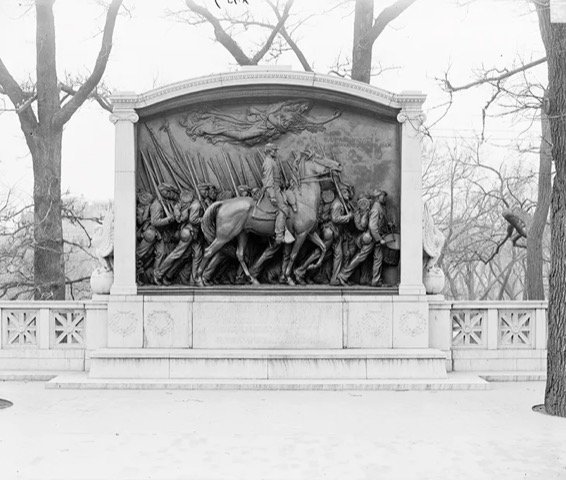Great Journeys Taken and Imagined
In the early morning coolness, before temperatures rise into the 90s in the Sierra foothills above Nevada City, I find myself daydreaming in dappled light while watering my garden. Saucer-shaped leaves dangling from a pot of nasturtiums remind me of lily pads captured by Impressionist artist Claude Monet. Then suddenly my mind drifts from Monet’s pond at Giverny to a scene stilled to silence by snow. While painting plein air in a rural village, Monet managed to capture effets de neige—winter sky and ground locked in a frigid blur the bluish white of ice. Then just as suddenly, I find myself on a winter walk in the Luxembourg Gardens in Paris.
In this wintry scene that my mind has entered, warmth emanates from the rich, honey-hued bark of magnificent, snow-covered horse chestnut trees lining the grand strollway. A marble statue aged by time and the elements glows as if illumined from within by amber light. The figure is of a woman in a short Grecian tunic, a dancer at pause, deep in thought.
Perhaps the woman is Isadora Duncan, a 23-year-old American who, after arriving in Paris in 1901 with her family, soon garnered enormous attention for her free-spirited performances of Greek and Florentine dances. Thrilled to be in “the City of Light,” Isadora and her brother were often seen dancing in the Luxembourg Gardens at five in the morning.
Drawn to the scene’s warm winter light, I take a walk of my own imagining in the garden where Isadora danced at the dawning of the 20th century. Laying a hand on a giant chestnut tree, I’m moved by its majesty. Up close, the color of its inner skin, revealed by peeling bark, mirrors that of the Greek dancer atop her marble plinth. Both are a pale golden caramel with amber highlights the color of winter grass at Boomerang Creek. In the magical winter light of Paris, both are alive with thoughts of spring.
Having just finished rereading David McCullough’s 2011 book, The Greater Journey, it is now difficult to leave the City of Light that inspired American artists, writers, doctors, politicians, and architects who set off for Paris between 1830 and 1900. On an imagined snowy walk through the Luxembourg Gardens, I realize that American sculptor Augustus Saint-Gaudens (1848-1907) and his wife Augusta had looked out on this very perspective from their apartment at 3 rue Herschel during the years they lived and worked in Paris.
Saint-Gaudens and other Americans who journeyed to 19th century Paris were eager to study and gain recognition in their fields. Most had never left home before or experienced another culture. The list of notable Americans McCullough follows to Paris is staggering—Elizabeth Blackwell, Oliver Wendell Holmes, Charles Sumner, Elihu Washburn, James Fenimore Cooper, Samuel F.B. Morse, Louis Moreau Gottschalk, Ralph Waldo Emerson, Nathaniel Hawthorne, Mark Twain, Henry James, Harriet Beecher Stowe, Henry Adams, George P.A. Healy, John Singer Sargent, Winslow Homer, Mary Cassatt, and Augustus Saint-Gaudens.
Not long after I’d first read McCullough’s The Greater Journey, I met William J. Williams—a sculptor with an iron handshake you don’t soon forget. He has an impressive resumé of commissioned works on exhibit in the Hall of Famous Missourians at the Missouri State Capitol Building. Eager to learn more about American sculptor Augustus Saint-Gaudens, I mentioned him to Williams, careful to pronounce the acclaimed sculptor’s distinguished name with French flair. Straining for a moment to hear in the din of the room, Williams suddenly broke into a smile of recognition, pronouncing “Augustus” like its namesake month. “Of course,” I laughed, recalling that “Gus” Saint-Gaudens—the son of an Irish immigrant shoemaker and French mother—had grown up in New York City.
I also learned that Williams served from 2004-2007 as Sculptor-In-Residence at the Augustus Saint-Gaudens home in Cornish, NH, now a National Historic Site managed by the National Park Service. I recalled the sculptor’s Robert Gould Shaw Memorial installed in Boston in 1897 depicting African American soldiers of the 54th Massachusetts regiment falling into step on their way to Fort Wagner. The frieze demands our attention and brings each figure and this Civil War episode to life.
As my morning watering meditation comes to an end, I feel refreshed. It is fascinating where great journeys, both taken and imagined, transport us when we free our minds to wander. And just as wonderful are the connections across distances and time that we make along the way.




